Coral Hind
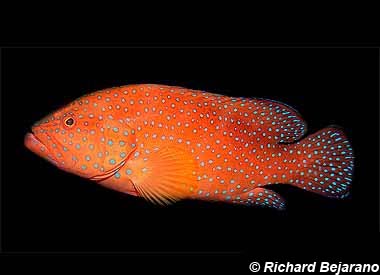
Cephalopholis miniata
These brightly colored fish prefer the open waters in and around reefs where they can hunt small fish and crustaceans. They are stout and almond-shaped, with orange-red to red-brown bodies covered in light blue spots ringed with darker red. Pectoral fins and undersides are usually more yellow, and other fins are rounded and darker reddish. They form harems of one male with several females, and each female has her individual territory within their home range.
Order: Perciformes
Family: Serranidae
Genus: Cephalopholis
Species: miniata
Common Names
English language common names are blue-spotted rock cod, coral hind, coral cod, coral grouper, coral rock cod, coral rockcod, coral trout, red coral perch, round-tailed trout, vermilion grouper, and vermilion seabass. Other common names include abo-abo (Visayan), alatan (Taglog), anansas batard (French), aroosa (Arabic), banolog (Bikol), bantol (Visayan), Baraka (Bikol), bato-bato (Ilokano), batol (Visayan), bertama (Arabic), chencheerachammam (Malayam), cherna estrellada (Spanish), chewa (Swahili), donu damu (Fijian), garoupa estrelada (Portuguese), graniec koralowy (Polish), guduudow-filfil (Somali), hamoor (Arabic), hamour (Arabic), hamrah (Arabic), hummarah (Arabic), iner (Visayan), inid (Bikol), iugiushaap (Carolinian), jahong (Visayan), juvelabborre (Swedish), juvelbars (Danish), juwelenbarsch (German), kakab (Ilokano), kaltang (Tagalog), kasaledamu (Fijian), kerapu bar (Malay), kerapu bara (Malay), kerapu bintang (Malay), kerapu karang (Malay), kigting (Bikol), koraal-klipkabeljou (Afrikaans), kubing (chavacano), kugtong (Visayan), kugtung (Bikol), kulapo (Tagalog), kurapo (Ilokano), kurapu (Ilokano), labungan (Visayan), lapu lapu (Tagalog), lapu-lapu (Davawenyo/Kapampangan/Kuyunon/Surigaonon/Tagalog), lapu-lapung lupot (Tagalog), liglig (Hiligaynon), ligmelial (Carolinian), lilug (Visayan), loche sanguine (French), lubo (Tagalog), malau pokoahu (Niuean), mamonbong (Visayan), mantis (Chavacano), maskad (Ilokano), matkad (Ilokano), Mérou minium (French), ngatala pulepule (Tongan), ogaw (Visayan), pagupo (Surigaonon), polo (Gelu), pugapo (Surigaonon/Visayan), pugapo salapok (Cebuano), pugayo (Visayan), raiy faana (Maldivian), rero (Tahitian), salingukod (Visayan), sheneenoh (Arabic), shnenu (Arabic), sibog (Visayan), sigapo (Tagalog), sikkifana (Mahl), sivari baba (Gela), summan (Arabic), tabadlo (Visayan), tangk-an (Visayan), ting-ad (Visayan), tingag (Waray-waray), ulibelila (Misima-Paneati), vieille chinois (French), vieille ananas (French), vieille de corail (French), vieille rouge (French), vieille de corail (French), and yukatahata (Japanese).
Importance to Humans
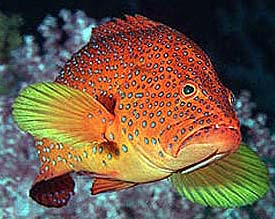
The coral hind is fished commercially and is considered of economic importance to local fisheries. It is also fished as a gamefish in recreational fisheries and is often caught with hook and line, spear, and in fish traps. This species is also a favorite in public aquaria due to its flashy red color and bright blue spots.
Conservation
Due to its importance in local fisheries, the coral hind is threatened by both overfishing and habitat degradation from fish-bombing and sedimentation. It is listed as a species of “Least Concern” by the World Conservation Union (IUCN) due to its large distribution, moderately common in some areas, and occurs within a number of marine protected areas. However overfishing and habitat degradation create cause for concern and need for additional monitoring.
> Check the status of the coral hind at the IUCN website.
The IUCN is a global union of states, governmental agencies, and non-governmental organizations in a partnership that assesses the conservation status of species.
Geographical Distribution
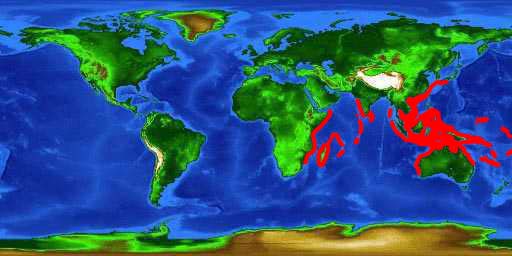
The coral hind is found in the Indo-Pacific region from the Red Sea to Durban, South Africa and east to the Line Islands including most islands located in the Indian Ocean and west central Pacific Ocean. In Australian waters, the coral hind resides from the central Western Australia coast to the tropical north coast and down the east coast to northern New South Wales. It is notably absent in the Persian Gulf and the Gulf of Oman.
Habitat
A reef-associated species, the coral hind is found in the clear waters typically in the more exposed portions of reef habitats from depths of 7-492 feet (2-150 m). It forms harems consisting of a dominant male and 2-12 females. Each harem occupies territories of up to 475 sq m which is then divided into sub-territories with each defended by a single female. Coral hinds are generally common in the areas they inhabit.
Biology
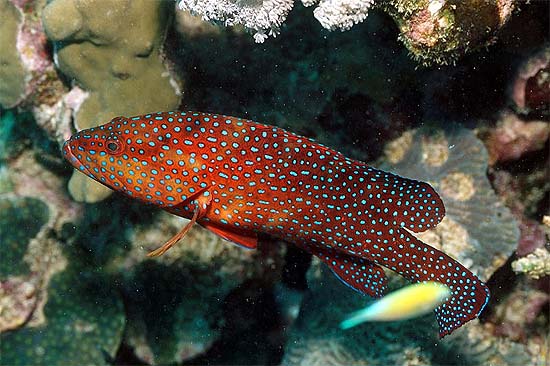
Distinctive Features
The body is oblong and robust with an interorbital area flat to slightly convex and a rounded preopercle. The anterior and posterior nostrils are subequal in size. The dorsal fin margin is rounded in adults; the pelvic fins typically do not extend to the anus. The anal fins and caudal fin are rounded. The pectoral fins are symmetrically rounded.
Coloration
Coral hinds are orange-red to a reddish brown in color, usually darker on the posterior portion of the body. There are numerous bright blue spots usually with dark edges on the head, body, and median fins. The distal margin of the caudal fin and the soft portions of the dorsal and anal fins typically have a narrow blue margin and a blackish submarginal line. The pectoral fins are orange-yellow distally; the pelvic fins are orange-red with a dark blue gray distal margin. Juvenile coral hinds are more yellowish on color with fewer faint blue spots than the adults.
The coral hind may be confused with the sixblotch hind (C. sexmaculatus), however it can be distinguished by its coloration. The sixblotch hind has dark blotches along the dorsal surface as well as blue lines radiating from the eyes while the coral hind has neither coloration characteristics.
Dentition
Coral hinds have small canines in the front of the jaws. Teeth are present on the palatines.
Size, Age, and Growth
The maximum reported length of the coral hind is 18 inches (45.0 cm) total length (TL). Sexual maturity is attained when coral hinds reach 10 inches (26.0 cm) TL.
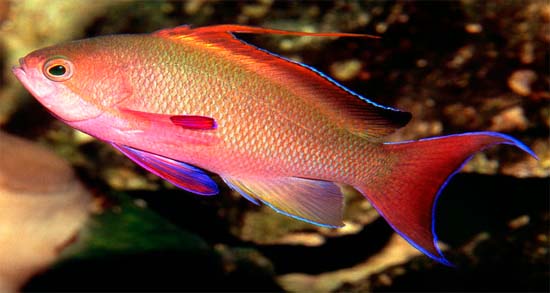
Food Habits
Feeding primarily during the early morning and midafternoon hours, the coral hind preys mostly on small fishes. The majority of its prey (80%) is Pseudanthias squamipinnis, however it also feeds on Anthias spp., Apogon spp., and Canthigaster margaritata. In addition, it feeds on crustaceans. It is an ambush predator, spending much of its time on the bottom, hiding and waiting for easy prey.Reproduction
Coral hinds form interspecific haremic groups consisting of one dominant male and two to twelve females. Each group occupies territories of 475-2,000 square meters which is further divided into secondary territories with each inhabited by an individual female coral hind. Behavior includes patrolling by males, visiting females, and antiparallel swimming of the sexes.
Predators
Potential predators of the coral hind include larger fishes and marine mammals.
Taxonomy
The coral hind was originally described as Perca miniata by Forsskål in 1775. This name was later changed to the currently valid scientific name Cephalopholis miniata (Forsskål 1775). Synonyms referring to this species appearing in past scientific literature include Cephalopholis miniatus Forsskål 1775, Serranus miniatus Forsskål 1775, Epinephelus miniatus Forsskål 1775, Pomacentrus burdi Lacepède 1802, Serranus cyanostigmatoidesBleeker 1849, Serranus perguttatus De Vis 1884, Cephalopholis maculatus Seale & Bean 1907, Cephalopholis formosanus Tanaka 1911, and Cephalopholis boninius Jordan & Thompson 1914. The family Serranidae includes 62 genera with a total of 449 species. Serranidae is derived from the Latin “serranus” meaning fish, fish saw. The genus Cephalopholis is made up of 22 species from throughout the world.
Prepared by: Cathleen Bester